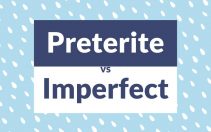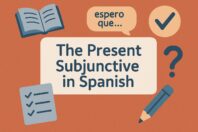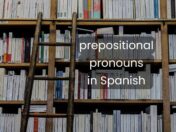Guide: How To Use The Passive Voice In Spanish

Get our free email course, Shortcut to Conversational.
Have conversations faster, understand people when they speak fast, and other tested tips to learn faster.
More infoEven if you are not 100% sure of its definition, there is a good chance that you’ve heard or used the Passive Voice in Spanish before.
In this post, we’ll explain exactly how to use the “voz pasiva” to sound more like a competent Spanish speaker.
Before we dig in, I should mention that a voice refers to the relationship between the subject and the verb in a sentence, and so a sentence is normally said in either the active voice or passive voice.
Let’s see an example of a similar sentence in both voices.
The active voice emphasizes the subject performing the action of the verb.
- José Luís reads the newspaper every day – José Luís lee el periódico todos los días
The passive voice in Spanish emphasizes the action, rather than the subject performing the action.
- The newspaper was read by José – El periódico fue leído por José
In the passive voice, the subject (José Luís) is mentioned at the end of the sentence, and becomes what we call a “passive agent”. In most passive sentences, mentioning the passive agent is optional.
The object (el periódico) in the active voice becomes the subject in the passive voice.
Below, you can see how the sentence changes, depending on which voice you use.
| Voice | Subject | Verb | Object | Complement | Agent |
| Active | José Luís | lee | el periódico | todos los días | |
| Passive | El periódico | es leído | todos los días | por José Luís |
We should mention that the passive voice in Spanish is considered more formal than the active voice, which is why it’s not as commonly used as its equivalent in English, for example.
In general, the passive voice is used more 1) in written media or literature or 2) when the subject is considered unimportant.
Let’s see some examples:
- Several corpses were found in the woods – Varios cadáveres fueron encontrados en el bosque
- All the emails were sent – Todos los correos electrónicos fueron enviados
- Her diamond was stolen last night – Su diamante fue robado anoche
As you can see, in the sentences shown above, we mentioned the action and the object, but not who did those actions – either because we do not have that information, or because it’s irrelevant.
How to Form The Passive Voice In Spanish
To reiterate, we use the passive voice to emphasize the action being performed, rather than the subject performing it.
While the passive voice in Spanish can be used with any tense, it is most commonly used when speaking in the past or in the future.
There are two ways to form the passive voice:
- Ser + Past Participle of the Verb + Por
- Se + 3rd person of the verb
1) Using “Ser” verb in a Passive Sentence
When you change to the passive voice in Spanish, the object in an active sentence becomes the subject in the passive sentence.
There are three rules to note about this form of the passive voice:
- You must always use the verb Ser (to be) along with the past participle of the main verb
- The past participle must always agree with the gender and number of the passive subject
- The agent (or passive agent) may be added at the end of the sentence by the preposition “por”, only when necessary
This will make more sense once we look at some examples.
For example, below we are changing the same sentence from the active voice to the passive voice.
| Active Sentence Structure
Subject + Action verb (conjugated) + Object + Complement
|
Passive Sentence Structure
Subject + Ser (conjugated) + Past Participle of Action Verb + Complement + Por (optional)
|
Now, more examples using different tenses.
| Spanish Tense | Active Voice | English | Passive Voice | English |
| Present Simple | Cientos de turistas visitan Latinoamérica mensualmente | Hundreds of tourists visit Latin America every month | Latinoamérica es visitada mensualmente por cientos de turistas | Latin America is visited by hundreds of tourists every month |
| Present Progressive | Ellas están escuchando una canción de Pearl Jam | They are listening to a Pearl Jam’s song | Una canción de Pearl Jam está siendo escuchada por ellas | A Pearl Jam’s song is being listened to by them |
| Simple Past (Preterite) | Claudia hizo galletas de chocolate y vainilla anoche | Claudia made chocolate and vanilla cookies last night | Las galletas de chocolate y vainilla fueron hechas anoche por Claudia | The chocolate and vanilla cookies were made by Claudia last night |
| Simple Future | Tomás reparará el televisor mañana | Tomás will repair the TV tomorrow | El televisor será reparado mañana por Tomás | The TV will be repaired by Tomás tomorrow |
| Imperfect | Adriana leía muchos libros de Stephen King | Luís used to read many Stephen King books | Muchos libros de Stephen King eran leídos por Luís | Many books of Stephen King were read by Luís |
| Present Perfect | Erika no ha terminado todavía el ensayo | Erika has not finished the essay yet | El ensayo todavía no ha sido terminado por Erika | The essay has not been finished by Erika yet |
| Past Perfect | Los chicos habían visto al sospechoso en la escena del crimen | The boys had
seen the suspect in the crime scene |
El sospechoso había sido visto en la escena del crimen por los chicos | The suspect had been seen by the boys in the crime scene |
2. The Passive “SE” or “Pasiva Refleja”
This is probably the most common form of the passive voice used by Spanish speakers on a day-to-day basis. It is used to talk about general requirements, suggestions, or well-known facts.
Although the passive voice is normally considered more formal than the active, this form (passive “se”) has a structure that sounds more natural and is preferred when speaking.
The passive “se” is straightforward to use since it is always formed in the 3rd person – be it a singular verb conjugation (él, ella, usted) or 3rd person plural (ustedes, ellos, ellas) depending on the context.
In other words, you will always use either:
- se + 3rd person singular conjugation
- se + 3rd person plural conjugation
Now, some examples of this form in action.
- This beer is sold in boxes containing 100 units – Esta cerveza se vende en cajas de 100 unidades
- Bilingual translators are requested – Se solicitan traductores bilingües
- Spanish is spoken in many cities around the world – Se habla español en muchas ciudades alrededor del mundo
- It is recommended to participate actively in the first class – Se recomienda participar activamente en la primera clase
- It is suggested to take two pills every morning – Se sugiere tomar 2 pastillas cada mañana
Passive Voice in Spanish: Exercises
Change the below active sentences into passive sentences.
(only add the passive agent if necessary)
- Robert abandonó la escuela hace 5 años
- Carolina ha visto un oso marrón cerca la casa de su vecino
- Emilio y sus amigos verán el partido de fútbol esta noche
- Tú habías escrito cientos de correos, pero no recibiste ninguna respuesta
- Verónica y sus amigas están comprando unos cócteles
- La hermana de Andrés limpia la casa todos los fines de semana
- El profesor está corrigiendo los exámenes de matemática
- Miguel y su papá pintaron la casa la semana pasada
- Ellas vendían muchas galletas y tortas en la tienda
- Vanessa descarga varias aplicaciones para su teléfono Android
Now, change the below passive sentences into active sentences.
- El gato fue encontrado encima del techo por los bomberos
- El piano es tocado a diario por los niños
- Tres computadoras habían sido arregladas y vendidas por el técnico
- La abuelita será visitada por sus nietos el próximo fin de semana
- Cientos de boletos fueron vendidos en la obra de teatro “Romeo y Julieta”
- Los restaurantes de comida venezolana eran visitados todo el tiempo por muchos turistas de Europa y Estados Unidos
- Una nueva novela de horror y misterio está siendo escrita por Dan Brown
- El último episodio de Juegos de Tronos ha sido visto por menos personas de lo esperado
- La ropa es diseñada por importantes personas del mundo de la moda
- Los artículos fueron publicados de forma imprudente por un periódico poco conocido
Answers
- La escuela fue abandonada hace 5 años por Robert
- Un oso marrón ha sido visto por Carolina cerca de la casa de su vecino
- El partido de fútbol será visto esta noche por Emilio y sus amigos
- Cientos de correos habían sido escritos por ti, pero ninguna respuesta fue recibida
- Unos cócteles están siendo comprados por Verónica y sus amigas
- La casa es limpiada todos los fines de semana por la hermana de Andrés
- Los exámenes de matemática están siendo corregidos por el profesor
- La casa fue pintada la semana pasada por Miguel y su papá
- Muchas galletas y tortas eran vendidas en la tienda por ellas
- Varias aplicaciones para Android son descargadas por Vanessa
Transform the next Passive sentences into Active sentences
- Los bomberos encontraron al gato encima del techo
- Los niños tocan el piano a diario
- El técnico había arreglado y vendido tres computadoras
- Los nietos visitarán a su abuelita el próximo fin de semana
- La obra de teatro “Romeo y Julieta” vendió cientos de boletos
- Muchos turistas de Europa y Estados Unidos visitaban los restaurantes de comida venezolana todo el tiempo
- Dan Brown está escribiendo una nueva novela de horror y misterio
- Menos personas de lo esperado han visto el último episodio de Juego de Tronos
- Importantes personas del mundo de la moda diseñan la ropa
- Un periódico poco conocido publicó los artículos de forma imprudente



